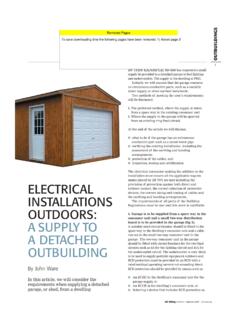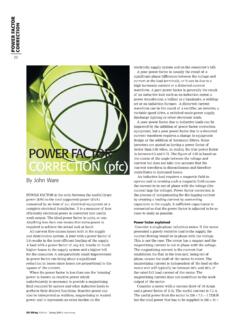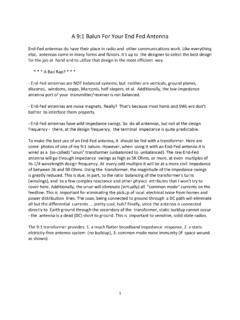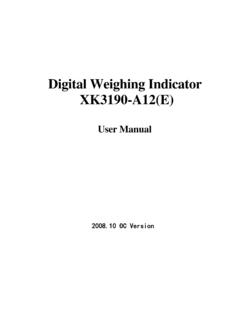Transcription of EARTHING ANDBONDING IN HAZARDOUS LOCATIONS
1 HAZADOUS. LOCATIONS . 10. EARTHING . AND BONDING. IN HAZARDOUS . LOCATIONS . By Mark Coles 1. Introduction Electrical connection maintaining various exposed- The IEE's Technical Helpline receives numerous calls conductive-parts and extraneous-conductive-parts at from contractors requesting information on the substantially the same potential'. EARTHING and bonding requirements for HAZARDOUS LOCATIONS . This article will give an overview of the There are two categories of equipotential bonding: hazards and problems encountered in those LOCATIONS and gives information on the performance Main equipotential bonding requirements of EARTHING and bonding to ensure that Regulation 413-02-02 of BS 7671 states: In each the potential for gas ignition, from low voltage installation, main equipotential bonding conductors electrical sources and equipment, is reduced. shall connect to the main EARTHING terminal extraneous conductive-parts of that installation.
2 2. The Regulations BS 7671, Requirements for Electrical Installations, is Supplementary equipotential bonding intended to be applied to electrical installations Regulation 413-02-27 of BS 7671 states: Where generally but, in certain cases, they may need to be supplementary equipotential bonding is necessary, it supplemented by the requirements or shall connect together the exposed conductive-parts of recommendations of other British Standards or by equipment in the circuits concerned and extraneous- the requirements of the person ordering the work. conductive-parts. Such cases would include the following: Supplementary equipotential bonding is not required Electrical apparatus for explosive gas atmospheres on every installation, generally however, it is required BS EN 60079 in areas of increased risk; BS 7671 recognises these Electrical apparatus for use in the presence of areas as Special LOCATIONS '. A HAZARDOUS location, of combustible dust BS EN 50281 course, would be considered as a special location.
3 3. Definitions BS 7671 further defines: Often, there is great confusion over EARTHING , bonding and even use of the nonsensical term, earth-bonding! BS An extraneous-conductive-part a conductive part 7671, Requirements for Electrical Installations, defines: liable to introduce a potential, generally earth potential and not forming part of the electrical installation . EARTHING Connection of the exposed-conductive- parts of an installation to the main EARTHING terminal An exposed-conductive-part a conductive part of of that installation.' equipment which can be touched and which is not a live Bonding the correct title is Equipotential bonding'. part but which may become live under fault conditions . IEE Wiring Matters | Spring 2006 | HAZADOUS. LOCATIONS . 11. Defining HAZARDOUS LOCATIONS Explosive gas atmosphere BS EN 60079-14: 2003, Electrical apparatus for Mixture with air, under atmospheric conditions, of explosive gas atmospheres Part 14: Electrical flammable substances in the form of gas or vapour, in installations in HAZARDOUS areas (other than mines), which after ignition, combustion spreads throughout defines the following: the unconsumed mixture.
4 Explosive atmosphere Explosive gas atmosphere HAZARDOUS area HAZARDOUS area Area in which an explosive gas atmosphere is present, or may be expected to be present, in quantities Note The ATEX 137 Directive has adopted the concept of such as to require special precautions for the space instead of area; by definition, area is a two-dimen- construction, installation and use of apparatus. sional concept, space is a three-dimensional concept. 4. The Zonal Concept In line with BS EN 60079-10: 2003, Electrical apparatus for LOCATIONS where flammable gases are, or may be, explosive gas atmospheres Part 10: Classification of present, are defined by a Zonal concept. The definitions, HAZARDOUS areas, this article will consider HAZARDOUS shown in the table below, of the particular Zones are LOCATIONS where gas ignition from low voltage taken from BS EN 1127-1:1998, Explosive atmospheres. electrical sources is possible but, for the purposes Explosion prevention and protection .
5 Basic concepts and of this article, the following LOCATIONS will not be Methodology. Each site will have drawings that will considered: indicate the extent of the Zones. The extent of the Zones a) mines susceptible to firedamp is established at the design stage by the competent b) the processing and manufacture of explosives person who is experienced in this line of work. c) areas where a risk may arise due to the presence of ignitable dusts or fibres 5. Hazards and Problems d) catastrophic failures which are beyond the concept The prime danger in explosive atmospheres is that of of abnormality explosions due to incendive sparking. Sparking can be e) rooms used for medical purposes caused by any of the following: f) areas where the presence of flammable mist may give rise to an unpredictable risk and which require Fault currents and high protective-conductor special consideration currents Flashovers' could occur on poorly earthed circuits Explosive atmosphere where expected and non-expected protective- Mixture with air, under atmospheric conditions, of conductor currents are present.
6 Flammable substances in the form of gas, vapour, mist or dust, in which after ignition, combustion spreads static electricity throughout the unconsumed mixture. static electricity is the retained charge on a Zone Definition Example Zone 0 A place in which an explosive atmosphere consisting Typically, the space above the liquid in a of a mixture with air of flammable substances in storage vessel. the form of gas, vapour or mist, is present continuously or for long periods or frequently Zone 1 A place in which an explosive atmosphere consisting The space immediately around a storage vessel's of a mixture with air of flammable substances vent-pipe openings which vent during filling. in the formof gas, vapour or mist, is likely to occur in normal operation occasionally Zone 2 A place in which an explosive atmosphere consisting of Around Zone 1, it is usual to consider the surrounding a mixture with air of flammable substances in the form space to be Zone 2.
7 Of gas, vapour or mist, is NOT likely to occur in normal operation but, if it does occur, will persist for a short period only. IEE Wiring Matters | Spring 2006 | HAZADOUS. LOCATIONS . 12. conductor. All the energy stored on the conductor can mass of earth. Incendive sparking could then occur be released in one arc or spark' to catastrophic effect. between the earth of the electrical installation and To retain charge on a conductor, it has to be insulated any extraneous metalwork which is in contact with from other conductors and insulated from earth by the general mass of earth. means of a non-conductor. Sparking, due to static electricity , can be avoided by using recognised Electrical equipment EARTHING and equipotential bonding techniques. Electrical apparatus for use in HAZARDOUS LOCATIONS must be suited for the gas group, the temperature static electricity is generated in many ways, including: classification and that particular protection concept.
8 The flow of liquids the mixing of powders 6. Performance requirements of EARTHING & bonding the production of sprays conductors in HAZARDOUS LOCATIONS the contact and separation of solids In this section, we'll look at the sizing of conductors static electricity causes problems in many and desired values of resistance. industries, such as chemical, pharmaceutical, petroleum, etc. Sizing of EARTHING conductors static electricity -discharges from a person can be In accordance with Regulation 543-01-03 of BS 7671, minimized by providing an adequately-conducting two methods may be used to size EARTHING conductors path between the person and earth through their or circuit protective conductors (CPCs); the first is the footwear and the floor. BS 7193 gives requirements for adiabatic equation, the second is Table 54G. two types of rubber footwear. Specifications for conducting-flooring materials and for such floors after Sizing of equipotential bonding conductors laying are given in BS 2050 and BS 3187.
9 In accordance with Regulation 547-02-01 of BS 7671. The phenomena that is static electricity is covered and excluding PME as previously stated, a main in great depth in two parts of BS 5958: 1991, Code of equipotential bonding conductor shall have a CSA not practice for Control of undesirable static electricity : less than half the CSA required for the EARTHING Part 1: General considerations, and Part 2: conductor of the installation and not less than 6 mm2. Recommendations for particular industrial situations. The cross-sectional area need not exceed 25 mm2 if the bonding conductor is of copper or a CSA affording lightning protection system equivalent conductance in other metals. Regulation 413-02-02 of BS 7671 requires that in each Further, Regulation group 547-03 of BS 7671, installation, main equipotential bonding conductors requires that supplementary equipotential bonding shall connect to the main EARTHING terminal extraneous- conductors are sized according to both their conductive-parts of that installation, including the particular application and whether they are lightning protection system.
10 However, the designer of mechanically protected. NOTE Table 10B of the IEE. the installation, who is a competent person, may decide publication, The On-Site Guide, is a handy reference that, due to particular risks, main equipotential bonding guide for sizing such conductors. of the lightning protection system should be avoided. Further, Guidance Note 3, Inspection and Testing, For further information, consult: BS 6651, Code of published by the IEE, advises that supplementary practice for protection of structures against lightning equipotential bonding conductors should have a and BS 7430, Code of practice on EARTHING . resistance of , or less. The electrical supply Eliminating static electricity The following electrical systems are NOT suitable for BS 5958-1: 1991, Code of practice for Control of use in HAZARDOUS LOCATIONS : undesirable static electricity Part 1: General TN-C considerations, states that to retain a significant TN-C-S (PME) electrostatic charge, a resistance to earth in excess of 1M is required.













